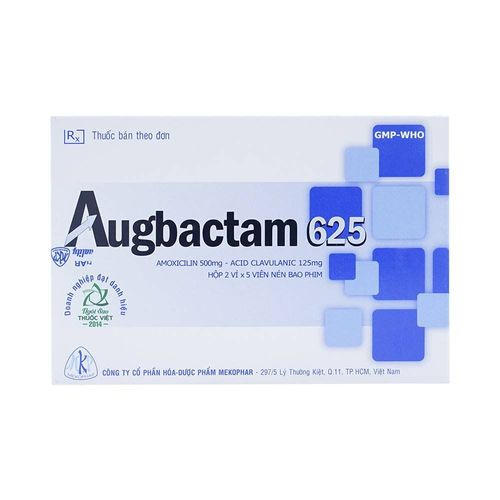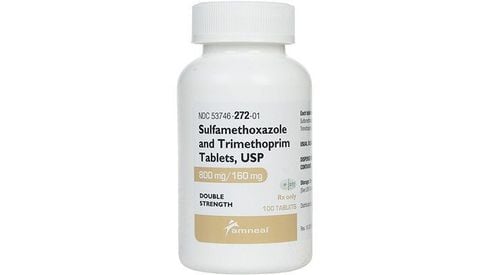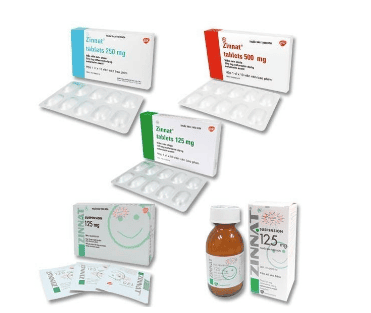This is an automatically translated article.
Augbactam is a broad-spectrum antibiotic used for the short-term treatment of mild to severe infections.
1. What is Augbactam?
Augbactam is a broad-spectrum antibiotic used for the short-term treatment of mild to severe infections. The main ingredients include Amoxicillin and Clavulanic Acid.
Pharmacodynamics
The combination of Amoxicillin with clavulanic acid prevents Amoxicillin from being destroyed by beta-lactamases, and at the same time effectively extends the antibacterial spectrum of Amoxicillin to many bacteria that are resistant to Amoxicillin, penicillins other and Cephalosporins such as:
Gram-positive bacteria: Streptococcus pneumoniae, Streptococcus pyogenes, Streptococcus faecalis, Streptococcus viridans, Corynebacterium, Bacillus anthracis, Staphylococcus aureus Listeria monocytogenes, Clostridium species, Peptococcus, Peptostreptococcus. Gram-negative bacteria:, Escherichia coli, Proteus mirabilis, Proteus vulgaris, Klebsiella species, Salmonella, Neisseria gonorrhoeae, Neisseria meningitidis, Haemophilus influenzae Vibrio cholerae, Pasteurella multocida, Bacteroides species including B.fragilis, Shigella, Bordetella. Pharmacokinetics: Both Amoxicillin and Clavulanic Acid are readily absorbed from the oral route. After taking the drug 1-2 hours, both active ingredients reached peak plasma concentrations. The oral bioavailability of Amoxicillin is 90% and Clavulanic Acid is 75%. The biological half-life of Clavulanic Acid is about 1 hour and is similar to that of Amoxicillin in serum about 1-2 hours. Approximately 55-70% of Amoxicillin and 30-40% of Clavulanic Acid are excreted unchanged in the urine.
Dosage form: Tablets
Packing form: 7 tablets/blister, box of 2 blisters or 5 tablets/blister, box of 2 blisters
2. What does Augbactam do?
2.1.Indications Upper respiratory tract infections: Sinusitis, otitis media, tonsillitis have been treated with common antibiotics but not relieved. Lower respiratory tract infections by beta-lactamase-producing strains of H.influenzae and Branhamella catarrhalis: Acute and chronic bronchitis, bronchopneumonia. Severe infections of the urogenital tract by beta-lactamase producing strains of E.coli, Klebsiella and Enterobacter: Cystitis, urethritis, pyelonephritis (female genital tract infection). Skin and soft tissue infections: Boils, infected wounds, abscesses. Infections of joints and bones: Osteomyelitis. Dental infections: Alveolar abscess. Other infections: Obstetric and gynecological infections and intra-abdominal infections. 2.2. Contraindications Patients with hypersensitivity to beta-lactamases (penicillins, cephalosporins). People with a history of jaundice or hepatobiliary disorders caused by taking Amoxicillin, Clavulanate or Penicillins.
3. Dosage and how to use Augbactam
3.1. Dosage The therapeutic dose is calculated according to the amoxicillin content in Augbactam.
Children > 12 years old and adults:
Mild and moderate infections: 500mg amoxicillin/tablet, every 12 hours. Severe infections: 500mg amoxicillin/tablet, given every 8 hours. Augbactam is not recommended for children 12 years of age and younger. 3.2. How to take Augbactam is taken orally. To minimize the phenomenon of drug intolerance in the gastrointestinal tract, the drug is indicated to be taken at the beginning of a meal. Treatment with Augbactam should not exceed 14 days without re-examination to monitor disease progression.
4. In case of overdose, forget the dose of Augbactam
4.1 Overdose When overdosed with the prescribed Augbactam, the drug has few adverse effects and is well tolerated even at high doses. However, the occurrence of acute reactions depends on the individual's hypersensitivity to the drug components. The risk of developing hyperkalemia is very high at doses compared with those recommended, because clavulanic acid is administered as the potassium salt. In this case, your doctor may recommend hemodialysis to remove the drug from the circulation.
4.2. Missed dose In this case, the patient should take the missed dose as soon as he remembers it. However, if it is almost time for your next dose, skip the missed dose and take your next dose as scheduled. Do not take a double dose on your own to make up for the missed dose. Patients should take the medicine at the same time every day to avoid forgetting the dose.
5.Augbactam drug side effects
During the use of Augbactam, patients may experience some of the following side effects:
Common undesirable effects: Diarrhea, rash, itching. Uncommon side effects: Eosinophilia, nausea, vomiting, hepatitis and cholestatic jaundice, increased transaminases. Rare adverse reactions: Anaphylaxis, Quincke's edema, thrombocytopenia, leukopenia, hemolytic anemia, pseudomembranous colitis, Stevens-Johnson syndrome, erythema multiforme, exfoliative dermatitis , toxic epidermal necrolysis, interstitial nephritis. The symptoms of side effects can be alleviated by reducing the dose of the drug. During the use of Augbactam, if there are any undesirable effects that are suspected to be related to the use of the drug, the patient should immediately notify the doctor for advice. In case the symptoms do not improve or worsen, immediately take the patient to the nearest medical facility for timely treatment.
6. Augbactam drug interactions
Patients being treated with anticoagulants when used in combination with Augbactam will be at risk of prolonging bleeding time and prothrombin time. Therefore, when there is a mandatory combination, be very careful and closely monitor the patient's condition. The doctor needs to ask if the patient who is prescribed Augbactam is taking oral contraceptives? This medicine may decrease the effectiveness of birth control pills. Probenecid does not affect the elimination of clavulanic acid but prolongs the elimination time of Amoxicillin. To avoid possible drug interactions, tell your prescribing doctor what medications you are taking or plan to take.
7. Some notes when using and how to store
7.1. Note when using It is necessary to consider when appointing the drug for patients with manifestations of liver dysfunction, kidney failure. Avoid using Augbactam for pregnant women, especially during the first 3 months. The necessary cases are prescribed by the doctor, when the benefits and risks have been weighed when taking the drug during pregnancy. The drug can be used during lactation, because this drug has a very low risk of harm to the nursing infant, except in cases where the child is allergic to a very small amount of the drug in breast milk. Augbactam does not pose a danger to the ability to drive and use machines. However, there are also a few studies that report the risk of dizziness, so the prescribing doctor can flexibly depend on the specific case to recommend or not recommend patients to take Augbactam when driving and operating machines. hook. 7.2 Storage Keep the medicine in a cool place, away from moisture and sunlight, at a temperature not exceeding 30 degrees C.
Keep out of reach of small children, do not put the medicine in the refrigerator or bathroom. When the medicine has expired or is not required to use it, do not throw the medicine down the toilet or water pipe. You can consult a doctor or environmental company for appropriate treatment.
Augbactam is a broad-spectrum antibiotic used for the short-term treatment of mild to severe infections. To ensure the effectiveness of treatment and avoid side effects, users need to strictly follow the instructions of the doctor, professional pharmacist.
Follow Vinmec International General Hospital website to get more health, nutrition and beauty information to protect the health of yourself and your loved ones in your family.
Please dial HOTLINE for more information or register for an appointment HERE. Download MyVinmec app to make appointments faster and to manage your bookings easily.













